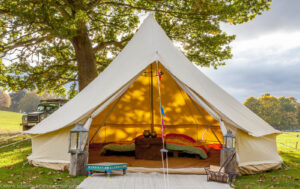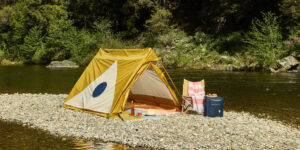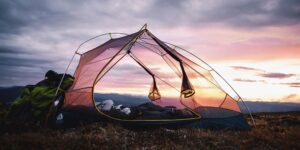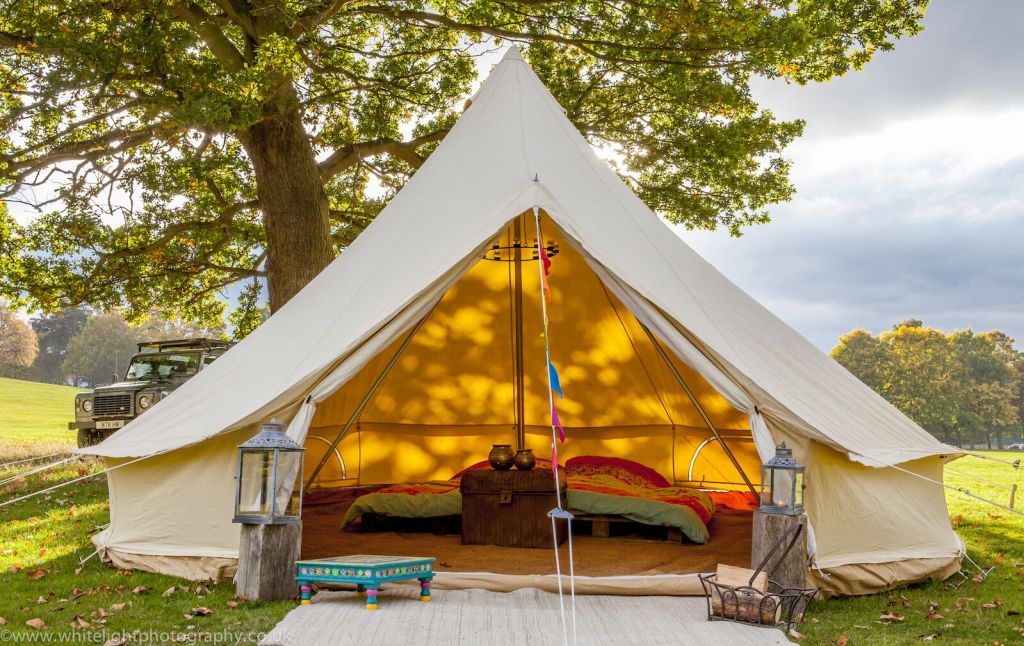The Best Camping Tent Buying Guide: How to Choose Your First Tent

It would help if you had the perfect tent when you’re ready to get out there and camp under the stars. But where do you start? This blog post will provide a buying guide for the best camping tents on the market. We’ll discuss everything from material and construction to features and price. By the end of this guide, you’ll have everything you need to make an informed decision when selecting your first tent.
What to Consider When Buying a Tent
The first consideration is what type of camping you plan on doing. If you are going car camping, you will need something to fit your vehicle. If you plan on hiking or backpacking with your tent, you will need something to hold up outdoors.
After determining what type of camping you will be doing, the next thing to think about is how much space you need. Most tents come in two sizes; small and large. The small size is good for 1-2 people, and the large size is good for 4-6 people.
Once you have determined how many people will be using the tent and what size they are, the next decision is whether to buy a model with an annex or without an annex. An annex is a room inside the tent where you can store belongings, making it easier for more than one person to sleep in the same tent at once.
Once you have determined all these things, it is time to shop for a Tent! Many different brands and models of tents are available on the market today, so it is essential to research before making any decisions. Once you have selected a model, read all of the reviews before purchasing so that you are aware of any potential problems that may occur with your new tent.
What Type of Tent is best for you?

If you are new to camping or even just thinking about buying your first tent, there are a few things to consider before making your purchase.
Different tents are designed for different purposes. For example, if you’re planning to use your tent mostly for sleeping in, then a backpacking or bivy-style tent is best for you. If, however, you’re more interested in using your tent as an outdoor living space – say for cooking over a fire or taking naps in the sun – then a more spacious and weatherproof camping tent is what you’ll need. Here are four different types of tents that can fit any camping need:
1. The Backpacking Tent:
This tent is perfect for anyone looking to camp in rugged terrain or who plans on carrying their shelter with them on their trips. They are lightweight and pack down small, making them ideal for short hikes or overnight car trips. Backpacking tents come in various sizes and styles, from single-person models to large family units that accommodate up to eight people.
2. The Bivy Tent:
Similar to backpacking tents but designed primarily for use when sleeping outdoors during bad weather conditions (i.e., rain or snow), bivys usually have extra features like waterproofing and stormFly technology that help keep you dry and warm. They’re also typically smaller than traditional camping tents, making them easier to pack and store.
3. The Camper Tent:
This type of tent is perfect for those who want more space than a bivy or backpacking tent can offer. They’re also often weatherproof and have features like built-in storage and awnings that make them perfect for outdoor living spaces. Camper tents can accommodate up to eight people but can be large and heavy to lug around on camping trips.
4. The Tourist Tent:
These are typically the most affordable tents on the market, making them an excellent option for families or friends looking to try camping out for the first time without spending too much money. They have simple designs and are less weatherproof than other types of tents, so they’re not recommended for use in bad weather conditions. Tourist tents are also less spacious than other types of tents, making them best suited for short camping trips rather than extended stays in one place.
How to Set Up Your Tent?
There are a lot of factors to consider when choosing the right camping tent. Here are four tips to help you choose the perfect one for your needs.
1. Size
Most tents come in three sizes: small, medium, and large. Choose the size that will fit both you and your camping gear. A small tent is good for two people, a medium tent for three-four people, and a large tent for five or more people.
2. Type
There are two types of tents: freestanding and cot-style. A freestanding tent has a different frame from the sheltering fabric, making it easier to set up and take down. Cot-style tents have an inner sleeping area made from a durable fabric and an outer cover made from lightweight mesh or cotton fabric. They’re lighter and easier to carry than traditional tents, but they offer less protection from the weather.
3. Weight and Material
You can make camping tents from various materials, including canvas, polyester fibreglass, nylon, polyurethane taffeta (PUT), or Mylar foil. Heavier materials provide excellent coverage and protection from the elements but also weigh more. Consider which features you want in your tent—weight vs. coverage—and choose a material that will provide those features while being lightweight enough to pack efficiently. It’s also important to find water and a weatherproof camping tent since these features will help protect your belongings from the elements.
4. Features
Some tents come with features like a rainfly to cover the sheltering fabric in inclement weather, pockets for storage, and Integrated LED Lighting (ILED) for enhanced visibility at night. Consider which features are important to you and choose a tent that includes them.
What to Do if the Tent Isn’t Setting Up Correctly?

If you’re camping in a tent for the first time, there are a few things to keep in mind before buying. First, make sure you know what size tent you need. Next, consider how much weight your tent can hold. Finally, find an easy-to-set-up tent that is comfortable and spacious. If these steps aren’t followed correctly, you could significantly hamper your camping experience. Here are some tips on how to set up a camping tent the right way:
- Make sure you have enough room inside the tent. The sleeping area dimensions are listed on the packaging or online, so remember to factor that in when choosing a tent. In addition to space for yourself and your gear, ensure enough room for your pet or other outdoor companions if you bring them along for the trip.
- Check the weight capacity of your chosen tent before buying it. Many tents are designed to hold up to 2 people and their gear, but check the weight limit before committing to one. Tents with higher weight capacities tend to be more expensive but may be worth it if you anticipate spending more time inside the shelter than outside it!
- Consider whether or not an easy setup is essential when selecting a camping tent. Some tents take longer than others to get ready for use and can be frustrating if things go wrong during setup. Look for a model with straightforward instructions that is quick and easy to put up.
- Make sure the tent is comfortable to sleep in. It includes checking the size, shape, and construction of the bed inside the tent. Make sure there is enough space between you and the tent’s walls to avoid trapping moisture and making breathing difficult.
- Consider purchasing a rain fly if you’re camping in areas that may experience inclement weather. A rain fly can keep your gear dry while you sleep and can be used as an extra sleeping area if needed.
The best features to look for in a camping tent:
Camping tents come in all shapes and sizes with various features. To choose the best one for you, it’s essential to understand what you need and what to look for. Here are the best camping tents features to look for in a camping tent:
-Weight and Packability:
The heaviest and bulkiest tents are usually the most extensive and expensive, but there may be better options if you’re looking for a versatile tent that you can take on long hikes or car campgrounds. The lighter and more packable tents will be less expensive but may provide less shelter or ventilation.
-Weather Resistance:
A good camping tent should handle light rain and strong winds. Look for a model with taped seams, well-sealing zippers, and a vent to help regulate temperature.
-Roominess:
Most camping tents have a minimum floor size of 90 square feet, enough space for two people but not enough room for larger groups. Check the tent’s dimensions before buying to ensure it will fit your needs.
-Price:
Most people find the best camping tents affordable but provide adequate shelter and weather protection. Look for models available at multiple retailers to find one appropriate for your budget.
How to choose the right size for your camping tent?
When choosing the perfect camping tent, remember a few things. First and foremost, you must decide what kind of camping you will do. Backpacking? Car camping? Tent camping?
Once you understand your needs, you can start narrowing down what type of tent is best for you. For backpacking tents, for example, consider weight and packability. Do you want a tent that you can haul around on your back or something that will fit into a small backpack? For car camping, consider things like ventilation and size.
Do you want a small tent that can fit in your trunk or something that can accommodate several people? Once you have determined what type of camping you will be doing and what kind of tent is right for you, it’s time to choose the size.
There are three main sizing categories: solo, two-person, and family. Solo tents are great for one who wants to have plenty of space but not take up too much space in their backpack or car. Two-person tents are suitable for couples or small families who want enough room to spread out but don’t want a lot of extra weight carrying around with them. Family tents are designed for groups of up to four people and offer more room than solo or two-person tents but require more packing space due to their larger size. Once you know your tent’s size category, it’s time to choose the model.
What type of material to choose for your camping tent?
Camping tents come in all shapes and sizes, but the most important thing to remember when purchasing one is that you need enough room for both you and your gear. Before making your purchase, consider the space you need and the type of camping you plan to do.
A three-season tent will give you plenty of space for backcountry camping or extended camping trips. These tents typically have a high peak, allowing more light and airflow. You better suit a two-season model if you’re looking for a tent that can handle a little rain or snow. These tents are waterproof but not airtight, so they’ll still provide good protection from the elements in milder weather conditions.
If you only plan to use your tent occasionally during the summer or live in an area where hurricanes are rare, an inflatable camping tent might be best for you. These models are easy to set up and take down and can be used anywhere there is access to fresh air. Remember that these tents do not provide much coverage from wind or rain; if bad weather is forecasted, it’s best to pack an extra layer of clothing.
Whatever type of camping you’re interested in, be sure to check out the different models and choose the one that’s perfect for you.
Top Ten Tips for Sleeping in a Tent

If you’re new to camping or just looking for a more comfortable way to sleep outside, a tent is a way to go. But before you buy one, here are some tips to help you choose the perfect one for your needs.
1. Consider your budget:
The first thing to consider when buying a tent is your budget. There are a lot of great tents out there, but they range in price from around $30 to well over $400. If money is an issue, start by checking out online reviews of popular tents and picking one that would fit your needs and budget.
2. Think about what kind of camping you’ll be doing:
If you’re starting and haven’t camped much yet, a three-person tent might be your best camping tent. But if you’re an experienced camper looking for something bigger and more luxurious, consider investing in a four- or five-person tent.
3. Consider the type of weather you’ll be camping in:
Tent types vary based on the climate they’re meant for—for example, an ultralight tarp can work well in warm weather but may not be durable enough in cold weather. Check the forecast before shopping to know which type of weather is expected where you plan on using your tent.
4. Consider how often you’ll use your tent:
Some people only use their tents once or twice a year, while others backpack and camp frequently. It will help you determine the tent type best for your needs and budget.
5. Consider how much space you’ll need:
A typical tent has a sleeping area, a storage area, and an area to stand or sit in. Make sure to factor in the size of your sleeping area and the amount of storage you need.
6. Determine what weather protection you need:
Most tents have an automatic or manual rain cover. Get a rain cover if you use your tent in wet or humid conditions.
Also Read: Buying The best camping tent with ac port Is The Best Way To Survive In Summer
7. Consider the dimensions of your tent:
Most tents have a width and height specific to their design. Make sure to measure these dimensions before buying to know what size tent will fit inside your car or backpack.
8. Consider the number of people who will be using the tent:
A two-person tent is typically smaller than a four-person tent, so if you’re planning on camping solo, consider looking for a two-person option instead of a four-person one.
9. Check out the ground cover:
Many tents have an optional cover that helps protect the surface underneath from moisture and dirt. If you’re camping in an area with dust or dirt, consider getting a tent with ground cover.
10. Consider the tent’s features:
Many tents come with features like integrated rain flaps, screens that allow you to keep bugs and insects out, and zippered windows that let you see outside without having to open the door.
Conclusion
If you’re thinking about camping for the first time or have been camping sporadically for years, it’s important to have a good tent. But which one should you buy? In this article, we’ll discuss key factors to consider when buying your best camping tents and provide a list of our favourite ones on the market. With careful consideration of these factors, I hope you can find the perfect tent for your next trip!

